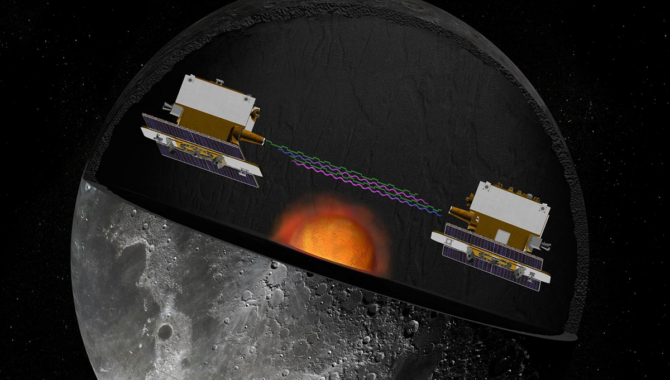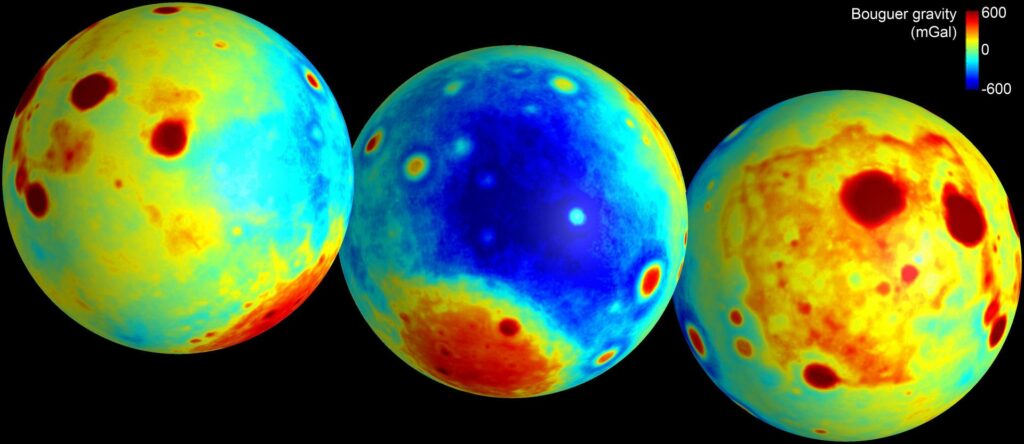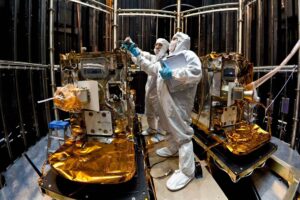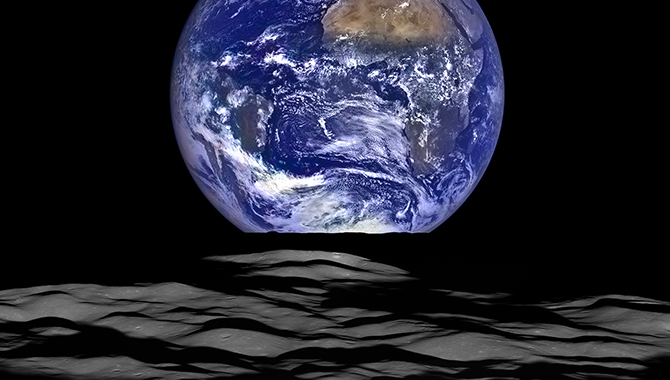
NASA’s GRAIL mission measured the Doppler shifts of twin spacecraft to identify the Moon’s gravitational anomalies and internal structure. Artist Rendering Credit: NASA/JPL
Twin spacecraft reveal the Moon’s complex interior and history.
In the mid-1960s, as the United States and the Soviet Union were racing to put the first humans on the Moon, NASA’s Lunar Orbiter missions took thousands of photos of the lunar surface. Scientists and geologists used the images to identify landing spots, but the teams monitoring the spacecraft noted something curious. When passing over dark areas on the Moon, the spacecraft accelerated toward the surface.
Scientists realized that variations in the Moon’s gravitational field were likely the cause. In 1968, aerospace engineer Paul M. Muller and scientist William L. Sjogren, working at NASA’s Jet Propulsion Laboratory, analyzed the Doppler shifts in radio signals from the Lunar Obiter spacecraft to identify areas on the Moon with mass concentrations, or “mascons,” that were driving the significant anomalies in lunar gravity.

These maps of the moon show the Bouguer gravity anomalies as measured by NASA GRAIL mission. Red areas have stronger gravity, while blue areas have weaker gravity. Credit: NASA/JPL-Caltech/CSM
They began discovering the mascons as soon as they printed their first lunar maps because the gravitational anomalies were very large — +200 milligals — and correlated with major lunar “seas,” large areas where lava flowed into ancient impact basins 3.9 billion years ago.
In research published in 1971, they found that some areas of the Moon have near zero gravitational anomalies. Others, such as the Mare Orientale, have dramatic patterns with a small area of stronger gravity at the center of a basin, surrounded by a ring of negative influence, surrounded by a positive ring. They found similar rings at other lunar mares.
On Earth, they noted, the geologic events that created the mascons on the Moon would quickly reach isostatic equilibrium and exhibit much smaller gravitational anomalies. For instance, the +200 milligals Muller and Sjogren observed in the data for Mare Serenitatis would have likely been -20 milligals on Earth. The findings were unexpected and raised important questions about the history, structure, and evolution of the Moon.

Technicians install lifting brackets prior to hoisting the 200-kilogram (440-pound) GRAIL-A spacecraft out of vacuum chamber after testing on April 29, 2011.
Photo Credit: NASA/JPL-Caltech
On September 10, 2011, 13 years ago this month, NASA launched a mission designed to answer some of those lingering questions about variations in the lunar gravity field and the Moon’s internal structure. The mission is known as GRAIL, an acronym for the Gravity Recovery and Interior Laboratory. Part of NASA’s Discovery Program, GRAIL used proven technology from an earlier mission that measured gravitational changes on Earth related to ocean circulation and ice melt.
“GRAIL’s revolutionary capabilities stood out in this Discovery mission competition owing to its unsurpassed combination of high scientific value and low technical and programmatic risk,” said Alan Stern, who was NASA Associate Administrator for Science when he announced the mission in 2007. “GRAIL also offers to bring innovative Earth studies techniques to the Moon as a precursor to their possible later use at Mars and other planets.”
Two identical spacecraft launched aboard a single Delta II rocket, arriving at the Moon at the end of 2011. Named in a competition among school children, the spacecraft Ebb entered lunar orbit on December 31, 2011. The spacecraft named Flow entered lunar orbit on January 1, 2012. Built on a rectangular, composite satellite bus, each spacecraft had a 22 N thruster for propulsion, solar panels, a sun tracker, a star tracker, and the Lunar Gravity Ranging System (LGRS).
The LGRS took precise measurements of the distance between the two spacecraft as they orbited 34 miles above the lunar surface, separated by about 108 to 139 miles during the first phase of the mission. In later phases, Ebb and Flow were even closer to the surface of the Moon, and the distance between them varied.
“The mission actually operated pretty flawlessly,” said Dr. Maria Zuber, the mission’s principal investigator, speaking on NASA’s Gravity Assist podcast in 2019. “Although I will say, later in the mission when we brought the altitude down very low, I said, ‘It was like having a newborn baby that was up all night.’ You had to just watch it constantly, constantly, constantly, to make sure that nothing happened that we didn’t know about because you would have to do a close-to-immediate maneuver to avoid having one of the spacecraft crash into the surface.”

A linear gravity anomaly intersecting the Crisium basin on the nearside of the moon has been revealed by NASA GRAIL mission. The GRAIL gravity gradient data are shown at left, with the location of the anomaly indicated. Credit: NASA/JPL-Caltech/CSM
The mission returned some surprising results. It pinpointed mascons and confirmed they are the result of large asteroid impacts when the Moon was much hotter. GRAIL data indicated the Moon’s crust, which scientists had estimated was nearly 40 miles deep, is much thinner—as little as 21 miles. The crust is also heavily fractured and covers large volcanic structures.
“I think none of us in the scientific community had any comprehension that the lunar crust was as shattered as it is,” said Zuber, who is the Vice President for Research at MIT. “…At short wavelengths that are consistent with the shallowest crust, 98 percent of the gravity is gravity due to topography and only 2 percent of the gravity that we see is gravity due to anomalies or mass concentrations within the crust. And the only reason that that could be the case is if the crust has been completely broken up and homogenized…”
“But that 2 percent of the gravity within the crust is very, very interesting,” Zuber added. “For example, we found massive, massive volcanic dikes that point to an earlier time on the Moon when the Moon heated up and expanded. And it had been hypothesized decades ago and no evidence for it was ever seen at the surface. So, it turned out that these dikes at the surface were all broken up by the impacts, but the dikes still exist very deep in the crust.”
Ebb and Flow were intentionally crashed into the lunar surface on December 17, 2012. The information the mission collected about mascons gave scientists a better understanding of the geologic consequences of large impacts in the early solar system.
“Mascons also have been identified in association with impact basins on Mars and Mercury,” Zuber said, in a NASA press release. “Understanding them on the Moon tells us how the largest impacts modified early planetary crusts.”
To learn more about GRAIL, visit http://www.nasa.gov/grail and NASA – NSSDCA – Spacecraft – Details.









